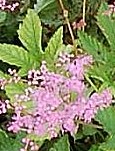 Siberian meadowsweet is a herbaceous perennial native to Siberia and a member of the rose family, Rosaceae, that also includes lady’s mantle, apples, and almonds. It is a compact plant with compound leaves. Each leaf is four to eight inches wide and consists of a seven to nine palmately lobed terminal leaflet three to eight inches in size with three to five lobed lateral leaflets one to three inches. The leaflets are deep green on the upper side and white and hairy on the lower side. The flowers are carried in flattened heads six inches wide and are pale pink fading to white. They bloom in late spring to early summer and persist for two to three weeks. The genus name Filipendula comes from the Latin words filum meaning thread and pendulus meaing hanging down, referring to the threads that hang from the roots of the type species, Filipendula hexapetala. The specific epithet palmata is the Latin word meaning lobed like a hand, referring to the leaves.
Siberian meadowsweet is a herbaceous perennial native to Siberia and a member of the rose family, Rosaceae, that also includes lady’s mantle, apples, and almonds. It is a compact plant with compound leaves. Each leaf is four to eight inches wide and consists of a seven to nine palmately lobed terminal leaflet three to eight inches in size with three to five lobed lateral leaflets one to three inches. The leaflets are deep green on the upper side and white and hairy on the lower side. The flowers are carried in flattened heads six inches wide and are pale pink fading to white. They bloom in late spring to early summer and persist for two to three weeks. The genus name Filipendula comes from the Latin words filum meaning thread and pendulus meaing hanging down, referring to the threads that hang from the roots of the type species, Filipendula hexapetala. The specific epithet palmata is the Latin word meaning lobed like a hand, referring to the leaves.
Type: Herbaceous perennial
Bloom: Flattened heads six inches wide of pink flowers fading to white in late spring to early summer
Size: 3-4’ H x 3’ W
Light: Full sun to part shade
Soil: Average, moist to wet
Hardiness: Zones 3-8
Care: Remove foliage after bloom if it declines in summer.
Pests and Diseases: Powdery mildew
Propagation: Division in fall, seed
Companion Plants: Japanese iris, bee balm, candelabra primula, knotweed, hosta, ferns
Outstanding Selections:
‘Elegans’ (White flowers with red stamens; more compact that species)
‘Nana’ (6-12” H)